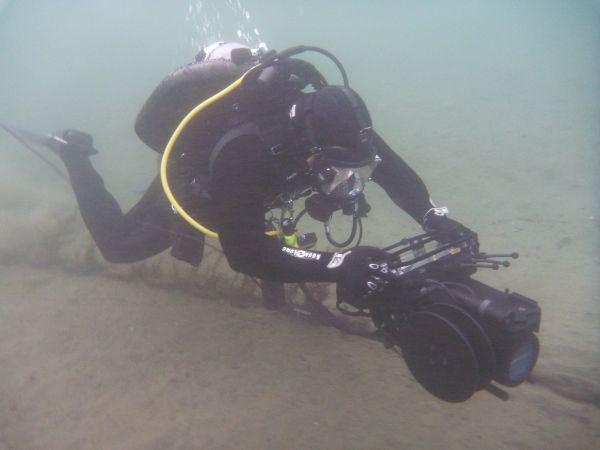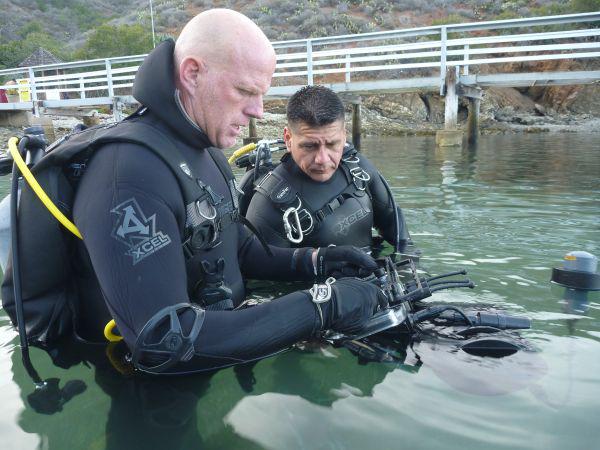Diving for Port Security
The Long Beach Police Department dive team adopts new homeland security equipment.
The Long Beach, California, police department dive team is now using a newly acquired search and recovery system to help protect the local port, shipping lanes and critical infrastructure.
The Long Beach Police Department (LBPD) dive team has an atypical and varied mission along the port and in the city waterways. “We have the law enforcement responsibility as well as the homeland security mission, mostly dealing with the Port of Long Beach and protecting the port against any type of terrorist threat or action,” says Sgt. Steve Smock, LBPD dive team supervisor. “Everything that the police do on land, we do underwater.”
The mission can include body recovery after a shipping accident or searching for underwater mines attached to ships or piers. The LBPD works with U.S. Customs and Border Protection to search for and confiscate narcotics or other contraband being smuggled into the country. Additionally, the port is a potential terrorist target for several reasons, including the shipping lanes and some of the cargo coming into port.
“We have all these different wharfs and piers that these ships come up to and tie to. A good example is the oil exchange terminals where the oil container ships come in and offload their oil. These are, for obvious reasons, very sensitive. We do a lot to make sure that nobody gets in there to tamper with anything,” the sergeant states.
Sgt. Smock adds that the port is an industry of more than one billion dollars per day. “If the port gets shut down for any reason, it affects the local economy the first day, the state economy the second day and the national economy on the third day. So, it’s a pipeline of commerce, and any disruption in it sends pretty devastating ripple effects throughout the nation pretty quickly,” he explains.
Using funding from the Port Security Grant program, the dive team recently acquired an underwater search and recovery system that includes a side scan sonar, tripod-mounted scanning sonar, a pole-mounted multibeam imaging sonar, and two diver-held imaging and navigation systems, all operated through a single software program on a waterproof topside console.
The equipment will help the team to better see what rests beneath the surface. “Our water conditions here usually range from zero to maybe 6 feet of visibility. This system allows us to see underwater. It allows us to map our structures, our critical facilities underwater, and also to document the things we find. The team can send a diver to quickly locate an object, video it, gather sonar data and, if necessary, recover it.
In some cases, the system simply will allow the team to perform its mission more quickly so that the shipping lanes continue to run smoothly. If, for example, someone were to fall off a tugboat and drown, the traditional method of body recovery could substantially delay shipping. “With this system and how it all integrates, we can quickly get on-scene and locate a body. A diver can go down with the information that we found with the side scan sonars and then quickly go to that target. Then we can recover it quickly and go on. We don’t have to spend time sending multiple divers down there randomly searching an area,” Sgt. Smock says.
The system, known as SeaSAR (search and recovery) is built by Shark Marine Technologies Incorporated, Ontario, Canada. The dive team received the bulk of the equipment in September and already is putting it to use. “We’ve done routine checks of the critical facilities, and we’ve gone down and done some surveys and some mapping of the areas,” Sgt. Smock reports.
Industry is expected to continue tweaking the system, tailoring it for the dive team’s specific needs. For example, the team also owns sonar systems from Kongsberg, a Norwegian company, and from CodaOctopus Products Limited, Edinburgh, Scotland, which will be integrated into the Shark Marine SeaSAR system. Sgt. Smock indicates that it is the ability to integrate the system with other technologies, the range of helpful features and the ease of use that his team most appreciates. “We’re basically cops who know how to dive, and we’re not very technical. We get this technical piece of equipment, and we were able to learn it in a couple of days and then go out and apply it,” he says.






Comments